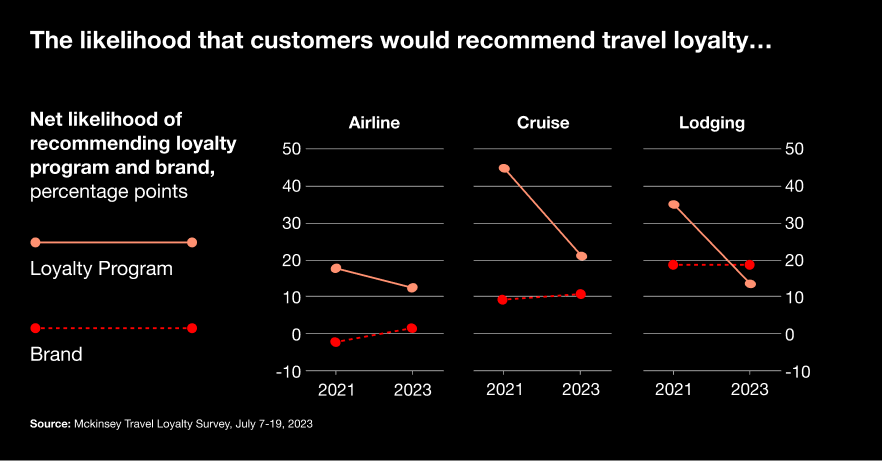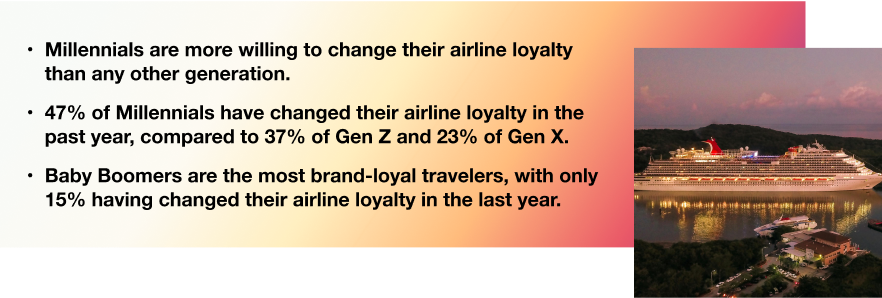From Miles to Memories
The New Era of Travel & Leisure Loyalty Programs

How Modern Loyalty Programs Shape the Travel and Leisure Industry
In an era where customer loyalty is paramount to the travel and leisure industry's success, understanding and adapting to the evolving market dynamics is crucial. This whitepaper will highlight key insights and statistics on the importance and effectiveness of loyalty programs and provide strategic guidance to stay competitive in this fast-paced industry.
Insight #1: The Shift from Rewarding Loyalty to Driving Profits
Since their inception in the early 1980s, major airline and hotel rewards programs have significantly shaped the travel industry. Initially designed to reward frequent customers and encourage brand loyalty, these programs have evolved into major revenue streams. For example, in 2019, United's MileagePlus program generated $3.8 billion by selling miles, accounting for 12% of its total revenue. Similarly, in 2022, American Airlines and Marriott generated $3.1 billion and $2.7 billion, respectively, from their loyalty programs.
Over time, however, the focus of these programs has shifted towards maximizing profits, often at the expense of customer experience. Recent policy changes, raising reward and redemption hurdles, have led to a notable decrease in customer satisfaction. Surveys indicate a decline in the likelihood of customers recommending these programs. For example, loyalty surveys from McKinsey highlight a marked decrease in customer satisfaction, contrasting with more stable brand recommendation rates for airlines and hotels. This shift in strategy highlights a significant challenge: balancing profitability with loyalty, which is crucial for sustaining long-term relationships with travelers.

The modern traveler's loyalty is increasingly driven by the quality of their experiences rather than simple rewards. Studies suggest that rather than the traditional "earn and burn" rewards, factors such as providing an experience worth paying extra for and feeling cared for have grown in importance. They now represent three of the top five loyalty drivers for cruise lines, hotels, and airlines.
For instance, the impact of experiential factors on purchase frequency in the hotel sector is four times greater than that of tangible benefits and more than twice as influential for airlines. This shift underscores the importance of focusing on customer satisfaction and experience to encourage genuine devotion, moving away from simply accumulating and redeeming points.

Insight #2: From Transactions to Connections: The Evolution of Loyalty Programs into Experiential Rewards
In another revealing 2023 survey by McKinsey, the results showed that only 20% of travelers were genuinely delighted by recent travel experiences, suggesting a significant opportunity for improvement. Travel companies are encouraged to focus on loyalty programs that offer experiential benefits, making each customer feel uniquely valued. For example, Delta Airlines has enhanced member satisfaction by offering complimentary in-flight Wi-Fi, significantly boosting program enrollments and enriching travel experiences. This shift underscores the importance of personalization—a staggering 63% of consumers prefer rewards programs that cater specifically to their needs.
This focus on personalization, relevance, and recognition in programs is vital. Today’s consumers seek memorable, enriching interactions that provide both choice and control, significantly enhancing their travel convenience and experience.
Building Emotional Connections through Recognition
This evolution from points to meaningful experiences is not just a trend but a necessary response to consumers' changing desires, emphasizing the shift toward creating memorable and meaningful customer connections.
The demand is evident, with studies showing that 78% of millennials prefer spending on experiences over physical goods. Additionally, data from Epsilon indicates that 80% of consumers are more likely to engage with brands that offer personalized experiences, further highlighting the impact of experiential rewards.

By focusing on personalization, recognition, and the human element, brands can transform their rewards programs into powerful tools for sustaining engagement and loyalty, shifting from mere transactions to deep, meaningful connections.
Insight #3: Simple, Flexible, Smart: The Three Pillars of Tomorrow's Loyalty
The crux of this insight lies in three main elements: simplicity, flexibility, and advanced technology. These factors are not only enhancing the way loyalty programs function but are also reshaping how they attract and retain valuable customers.
- Simplifying Complexity:
Brands are streamlining rewards programs by removing unnecessary layers, making them more straightforward and accessible. The aim is to transform complex systems into easy-to-navigate, rewarding experiences for consumers. - Embracing Flexibility:
Consumers want customizable and flexible rewards systems. Airlines and travel companies now allow points to be used for dining, shopping, and entertainment, reflecting an integrated approach to customer lifestyles. - Leveraging Advanced Technology:
Digital tools like mobile apps, online platforms, and AI modernize loyalty programs by enhancing user experience. These tools facilitate the management of rewards and status tracking, enhancing UX with seamless, personalized interactions. According to Salesforce, 75% of consumers expect companies to use new technologies to enhance their experiences.
Blockchain's Revolutionary Impact
Blockchain technology is emerging as a transformative tool in loyalty programs, providing unmatched transparency, security, and efficiency. It allows for the decentralized management of points, ensuring secure and instant verification of transactions, which boosts trust and reduces fraud. Singapore Airlines, for example, has pioneered the use of blockchain to let members use frequent flyer miles for everyday purchases, enhancing the utility and appeal of their offerings.
Real-World Innovations - Innovative features are being introduced to align loyalty programs with current consumer expectations for simplicity and flexibility. These include:
- Points Pooling: Families or groups can merge points for quicker redemption, enhancing the collective benefit and enjoyment.
- Instant Redemption: Provides real-time gratification by allowing points to be used like cash for a variety of purchases, from travel to everyday expenses.
- Digital Membership Cards: Stored on mobile devices for convenience and sustainability, these cards can be accessed instantly, removing the need for physical copies.
As these technological advancements continue to evolve, they are likely to significantly shape the future of loyalty programs, making them indispensable to the travel and leisure experience by offering more secure, transparent, and personalized engagement options.

INDUSTRY TRENDS
Trends of Today that are Impacting the Bottom Line
Let’s take a look at a few of the key trends that are shaping the future of loyalty programs, ensuring that they remain competitive and relevant.
Lifestyle Loyalty
Travel brands are partnering with lifestyle brands to diversify rewards. Airline loyalty programs now offer points for purchases at restaurants, online shops, and wellness services. This strategy extends beyond travel, integrating into customers’ daily lives and creating new revenue streams.
Expanding Partnerships
Travel companies have long partnered with banks for cobranded credit cards, but now they face competition from credit card brands with their own travel rewards ecosystems. Successful partnerships, like Uber’s with Marriott and Hyatt’s with Headspace, offer richer customer experiences and boost engagement. Travel companies must cultivate collaborations that generate revenue, personalize experiences, and retain loyal customers.
Subscription-Based Models
Subscription services, popular in streaming and meal kits, are now entering loyalty programs. Airlines offer subscriptions for unlimited benefits like Wi-Fi or seat upgrades. This model, growing rapidly, increases customer retention and revenue by providing consistent value and convenience.
A survey by McKinsey and Company found that the subscription e-commerce market has grown by more than 100% each year over the past five years. Applying this growth trend to rewards programs, businesses in the travel and leisure sector could see a significant increase in customer retention and revenue.
Gamification and Engagement
According to the International Journal of Information Management, gamification significantly increases user engagement and participation in loyalty programs. By integrating game-like elements such as challenges, badges, and leaderboards, travel and leisure brands are making participation in these programs more fun and rewarding. This approach not only increases customer engagement but also encourages repeat business and social sharing.
However, brands should be careful of how these elements are incorporated. Gartner predicts that 80% of gamified applications will fail to meet business objectives primarily due to poor design, underscoring the importance of well-designed gamification strategies in loyalty programs.
SUMMARY
The strategic value of loyalty programs in the travel and leisure industry is clear. By enhancing customer experiences with personalized engagement, exclusive rewards, and advanced technology, and by keeping pace with changing consumer trends, these programs are essential for brands competing in a dynamic market. Programs must also innovate and adapt, ensuring they meet contemporary needs and maintain loyalty on both local and global scales.
The emphasis on personalization is crucial; it transforms customer engagement from a generic process into a curated journey that values and recognizes the individuality of each customer. From priority check-ins and room upgrades to experiential rewards like exclusive tours or events, these programs are designed to make every interaction memorable.
At the heart of loyalty program innovation is technological advancement, with blockchain technology introducing a new layer of customer engagement and trust. Blockchain enhances the transparency and security of the rewards process, easing common concerns about the integrity of programs. Additionally, the use of digital platforms and mobile apps for managing loyalty accounts provides customers with the simplicity and flexibility that they expect in today's digital world. These technological advancements not only enhance the operational efficiency of rewards programs but also contribute to a seamless and engaging customer experience.
As customer expectations continue to evolve, so too must loyalty programs, which must adapt and innovate to meet the needs of the modern consumer and secure their loyalty both at home and afar.

To view the full list of references, click here: https://bit.ly/4e2zvnG
Thank you for your interest in our paper. Happy reading!